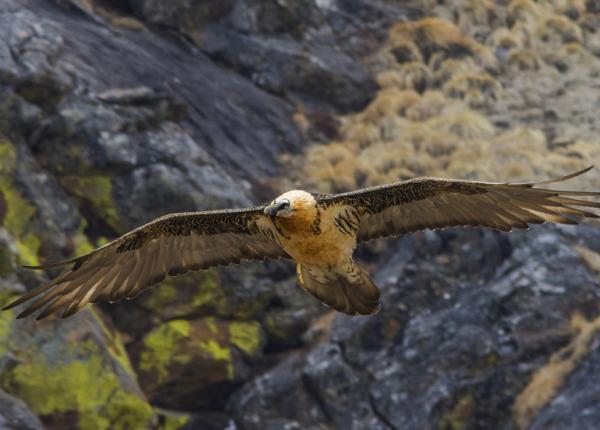Did You Know?
- The Bearded Vulture is also known as Lammergeier. However, Lammergeier means "sheep vulture" in German, which gives a negative connotation, suggesting that these vultures might prey on sheep.
- There is one recognized subspecies of the Bearded Vulture
- Though most vultures have featherless heads, the Bearded Vulture does not!
How The Peregrine Fund is Helping
The Peregrine Fund has been studying vultures in Kenya and other African nations since the early 1990s. Our initial efforts focused on scientific field studies, including placing radio transmitters on vultures to better understand their movement patterns related to where they travel and where they are most exposed to poisoning. While we continue these studies, we also conduct environmental education programs in the countries in which we work to help teach people about the importance of protecting birds of prey and their habitats, and we provide hands-on training to students and local biologists. In addition, we also installed anti-predator systems around Maasai livestock enclosures, called bomas, and evaluated their efficiency as a means to stop livestock depredation and subsequently deliberate wildlife poisoning. We also support teams working with Bearded Vultures in Asia.
Watch Munir Virani's TED talk about "Why I Love Vultures."
Where They Live
The Bearded Vulture is found throughout parts of Africa, Asia, and Europe. If you find yourself in Bearded Vulture territory, search for them in mountainous habitat, plains, and lowlands. They may be seen soaring at great heights over ridges and gorges, and sometimes "hanging" in the wind as they search for carrion below. When not soaring, it can also be seeing perching cliffs. Though these vultures are territorial when breeding, their ranges overlap among pairs when they are out foraging for food.
Why They Need Our Help
The Bearded Vulture is categorized as Near Threatened globally, but as Vulnerable in Europe. Though it is common some parts of its range, it is declining in others. Some threats include human persecution (mostly shooting), use of poisoned baits, habitat loss, and reduction in livestock farming. Sadly, the population of Bearded Vulture in the Alps was completely extinct by the beginning of the 20th century. However, since then, people and organizations, such as the Foundation for the Conservation of the Bearded Vulture, have been working hard to conserve this vulture and have engaged in reintroduction programs that have been successful!
What They Eat
This vulture is unique in many ways - one is its diet. It is one of the few, if only vertebrate, whose diet consists largely of bones and bone marrow. In fact, up to 90% of its diet is made up of bones. They will feed on some skin and meat, as well, but this is secondary. They will eat small and large bones, but seem to prefer larger, older bones. If they find a bone that is too large, they will carry it high up into the sky and drop it onto rocks below. This helps break up the bones into smaller, ingestible pieces. Researchers have also observed Bearded Vultures carrying turtles into the air and dropping them onto rocks to kill and eat them. These vultures may travel over thousands of square kilometers in search of food. In some parts of its range researchers have observed them gathering in large numbers in human settlements, where they feed at carcass dumps.
Nests, Eggs and Young
They are solitary nesters, meaning they don't nest in groups of other individuals of the same species. Bearded Vultures build large stick nests which they line with other materials such as smaller sticks, wool, hair, and even rags. It constructs its nest on sheltered ledges of rock cliffs. Pairs will use the same nest during subsequent breeding seasons, although they pairs don't nest ever year.
The female will lay 1-2 eggs, sometimes 3. The eggs must be incubated for around 55-60 days. Both the male and female take part in incubating the eggs, building the nest, and caring for the young. Once the nestlings hatch, they will grow quickly. However, because of aggression between the young birds, often only one nestling will survive. The surviving young vulture will be ready to fly from the nest when it is around 15-16 weeks old.
Bearded Vulture and the World Center for Birds of Prey
Though far from Bearded Vulture habitat, at the World Center for Birds of Prey, you will meet one of our best raptor ambassadors, Lucy, the friendly Turkey Vulture. You can visit her outside her chamber or watch her fly during our bird presentations. This is a wonderful chance to see a Turkey Vulture up close and learn to appreciate their unique beauty and amazing adaptations for survival.
Additionally, the World Center for Birds of Prey offers fun ways to learn about birds of prey. Interactive activities, tours, interesting videos and a children's room with activities from coloring sheets to quizzes to costumes. There is also a touch table with owl feathers and other natural objects for exploration.
Resources:
Global Raptor Information Network. 2021. Species account: Bearded Vulture Gypaetus barbatus. Downloaded from http://www.globalraptors.org on 6 Dec. 2021
Orta, J., E. de Juana, J. S. Marks, C. J. Sharpe, and E. F. J. Garcia (2020). Bearded Vulture (Gypaetus barbatus), version 1.0. In Birds of the World (J. del Hoyo, A. Elliott, J. Sargatal, D. A. Christie, and E. de Juana, Editors). Cornell Lab of Ornithology, Ithaca, NY, USA. https://doi.org/10.2173/bow.lammer1.01









